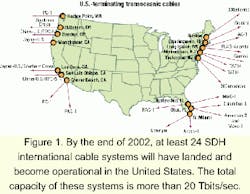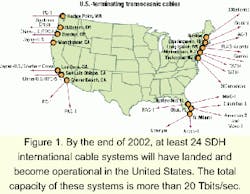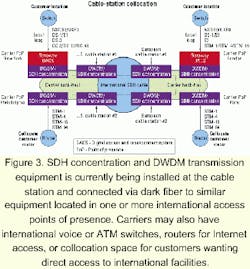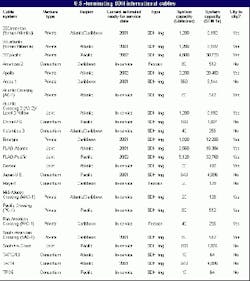New carrier market opportunity: back-haul from international cable systems
Demand for international capacity is huge, but bandwidth is only useful if it can be delivered to the end user.
JOHN GUDGEL, Lightscape Networks
An optical tidal wave is hitting the shores of the United States. By the end of 2002, at least 24 SDH international cable systems will have landed and become operational in the United States (see Figure 1). The total capacity of these systems is more than 20 Tbits/sec-a bandwidth sufficient, in theory, to allow every man, woman, and child in the United States to simultaneously make an overseas phone call.
In the transatlantic corridor alone, capacity in the next year will increase by more than 500%. This growth is spurred by hundreds of new global carriers and Internet service providers (ISPs) hungry for international bandwidth to satisfy their Internet backbone demands.However, international bandwidth is only useful if it can be delivered to the end user. Once an international cable is landed at a cable station, it still has to be extended from the station to a carrier's international point of presence (PoP) and, from there, via domestic networks to the end user. This cable-system back-haul can be the Achilles Heel of international capacity delivery, significantly increasing both the cost and provisioning time to implement service. Yet, for those carriers who understand the technical and economic challenges associated with back-haul and proactively implement back-haul solutions, there is a potentially large market opportunity.
The first international submarine cable system connecting England and France was laid in 1850. Used for telegraphy, it consisted of a single insulated copper wire that could transmit only one message at a time. Unfortunately, a fisherman cut the cable less than two days after going operational.
Undersea cables have come far since 1850. Most undersea cables installed today are protected fiber-optic ring systems with capacities capable of handling hundreds of thousands, or even millions, of simultaneous voice calls, thanks to DWDM technology. This technology allows multiple high-speed channels (currently 2.5 or 10 Gbits/sec), using different wavelengths (currently up to 40 colors) of light, to be transmitted over a single fiber (see Figure 2). Most international submarine cables being installed today consist of two, four, or eight fiber strands, typically configured in a ring.The carrying capacity of a cable system is: the number of fiber strands times the number of DWDM channels times the size of the DWDM channel times the type of configuration (one for point-to-point, two for a ring configuration). Thus, the carrying capacity of TAT-14 is: eight strands of fiber times 32 channels per fiber times 2.5 Gbits/sec per channel times two (ring) equals 1,280 Gbits/sec or 640 Gbits/sec (fully protected).
All international cables are currently being implemented using ITU standards that define optical transmission using the SDH. This optical transmission standard is different from the SONET standard used by domestic carriers in the United States. This difference is an important technical consideration when implementing international circuits since oftentimes this capacity must be converted from SDH to SONET to be transmitted over networks in the United States.
The basic unit of SDH capacity typically utilized in international cable systems is the STM-1 (155-Mbit/sec) circuit. Its SONET equivalent is an OC-3. Oftentimes, cable systems are sized based on their number of STM-1 equivalents. Thus, TAT-14, with a carrying capacity of 1,280 Gbits/sec (640 Gbits/sec ring-protected), can support up to 8,192 unprotected or 4,096 protected STM-1s.
Until a few years ago, virtually all international cables were built by consortiums consisting of a large number of global carriers that agreed to share the high cost of building the system. The carriers sign a construction and maintenance agreement that defines the amount of capacity each carrier owns in the system and the terms and conditions for participating in the cable construction and ongoing operation.
Cable-system capacity is purchased as an indefeasible right of usage (IRU). An IRU is like owning a condominium in a building. The owner pays an up-front capital price for the right to use a specific amount of capacity (e.g., an STM-1) for the lifetime of the cable (typically 15 or 20 years) and ongoing annual maintenance fees (typically 5-7% of the initial cost). Under the traditional consortium construction model, the IRU is only for the submarine portion of the capacity (cable station to cable station). The terrestrial portion, or back-haul, that connects the capacity from the cable landing station back into the owner's domestic network is not part of the IRU. This back-haul must be leased or purchased separately at considerable effort and expense.
Recently, a number of new cable systems have been financed and built by joint ventures (i.e., Gemini-a joint venture of WorldCom and Cable & Wireless) or by private cable companies such as Global Crossing Ltd. These new construction entities are changing the rules by which capacity is purchased. Among the most important changes is that IRUs are now being sold city-to-city, with a large portion of the back-haul at both ends being included in the IRU. But for the time being, a large number of cable systems continue to be built by consortiums, cable station to cable station, and still require that the capacity owner make their own arrangements for back-haul.
Table 1 lists the U.S.-terminating SDH cable system currently in operation or under construction. By the end of 2001, these new systems will increase the total capacity of bandwidth coming into United States by over 5,000 times versus pre-1995 levels. Subsequently, the price of IRU capacity has plummeted from more than $20 million per cable- station-to-cable-station transatlantic STM-1 in 1995 to sometimes less the $500,000 for a similar city-to-city STM-1 in 2001.
At the end of 2000, there were five transatlantic SDH cable systems operational between the United States and Europe: TAT-12/13 (1995), Gemini and AC-1 (1998), and Columbus 3 and AC-2 (2000).
TAT-12/13 is a ring system that connects the United States with France and the United Kingdom. It recently underwent an in-system upgrade that increased its ring-protected capacity from 5 to 10 Gbits/sec. Gemini and AC-1 are larger-ringed systems that broke the virtually monopoly TAT-12/13 had on transatlantic capacity from 1995 to 1997.
Gemini and AC-1 have been competing with each other since 1998. In the process, they drove the price down for a transatlantic STM-1 to less than $4 million per IRU. In late 2000, two new systems, AC-2 and Columbus 3, were completed, further intensifying transatlantic bandwidth competition. However, all of these systems will be facing much stiffer competition when several new terabit-capacity transatlantic cables are completed in mid-2001 and 2002.
The new transatlantic systems include TAT-14, FLAG Atlantic, 360americas (formerly Atlantica), 360atlantic (formerly Hibernia), and Apollo. When all are completed, the amount of transatlantic ring-protected capacity will have increased by more than 50,000 STM-1s. That may produce a glut of capacity and a buyers' market, as cable-system owners scramble to sell IRUs before the price drops out of the market. Already, prices have fallen to unprecedented lows; however, many companies are gambling that the demand fueled by the Internet will quickly consume the excess supply. As a result, existing cable-system owners are contemplating system upgrades and even discussing larger multiterabit systems.
For the past several years, the capacity situation has been very bleak for transpacific cable systems. Between 1995 and 1999, the only SDH cable system with any IRU capacity was TPC-5, and that bandwidth, when it was possible to find it, was very expensive. An in-system upgrade of TPC-5 from 5 to 10 Gbits/sec (ring-protected) in 1999 only relieved the transpacific capacity famine slightly.
The situation improved dramatically in early 2000 when two systems, China-U.S. and Pacific Crossing 1 (PC-1) went into operation. In addition, several other SDH cables are scheduled to go into full operation in 2001. These systems include Southern Cross, which will connect the United States with Australia and New Zealand and the Japan-U.S. cable. In 2002, two new terabit systems, 360pacific and FLAG-Pacific, are also scheduled to go into service.
There are a surprising number of new cable systems being implemented that connect the United States to Central and South America and to the islands in the Caribbean. These systems include Americas 2, Maya-1, Arcos, Emergia, and South American Crossing 1 (SAC). These systems all land in Southern Florida. In the case of SA-1, the landing is actually via another Global Crossing system, Mid-Atlantic Crossing (MAC), which is a feeder cable running from Florida to Bermuda (the actual SA-1 landing site), then to the AC-1 landing site on Long Island, NY. Another Global Crossing cable system, Pan-America Crossing-1 (PAC), will eventually connect from the Florida landing site for MAC to the California cable station for PC-1. At that point, Global Crossing will be able to provide transit service between all of its U.S.-terminating cables: AC-1, MAC, SAC, PAC and PC-1.
When an international submarine cable is landed in the United States, it's natural to assume it is a fairly easy matter to extend that capacity onshore from the cable station into a carrier's domestic network and, from there, to the end user's location. After all, fiber-optic transmission is in wide use in the United States, and the circuits run over dry land versus undersea. Common sense would dictate that any carrier with fiber capacity and a little bit of ingenuity could easily handle the task. In fact, cable-system back-haul implementation can at times be far from easy. There are several technical and economic issues that can make back-haul both difficult and expensive to implement.
To begin with, all international cables are currently being implemented using SDH technology. That means capacity on these systems is being transmitted as SDH-lower-rate circuits must be mapped onto higher-rate SDH circuits and the handoff of the circuits at the U.S. cable station is also SDH. Since the standard for fiber-optic transmission in the United States is SONET, delivering this capacity to the end user can be a challenge.
More and more, end-user equipment, such as routers and ATM switches, are being designed to support both SONET and SDH interfaces. The problem is getting the SDH circuit from the cable station to the equipment. One obvious solution is to convert the SDH capacity to SONET using some type of gateway protocol converter, multiplexer, or digital access and crossconnect system (DACS). These gateway boxes can perform the SDH-to-SONET conversion (e.g., STM-1 to OC-3) and, in some cases, can also map U.S. standard Plesiochronous Digital Hierarchy (PDH) capacity (T1, DS-3, etc.) onto international SDH circuits.
Another problem with back-hauling international circuits is economic. Until a few years ago, nearly all international submarine cables landing in the United States were terminated at stations belonging to AT&T. AT&T controlled access to these stations and as a result had a virtual monopoly on the international cable back-haul business in the United States. Carriers owning capacity on U.S.-terminating cables had to deal with AT&T, which set the rules and costs for activating back-haul capacity. The rules, which were bureaucratically adhered to, could cause lengthy provisioning delays resulting in back-haul intervals of sometimes six months or more. Furthermore, AT&T charged considerably more for SDH back-haul capacity versus comparable domestic SONET circuits.
Recently, the AT&T back-haul mono-poly was broken. Systems such as Gemini and AC-1 sell service city to city. City-to-city service includes the back-haul from cable station to select major metropolitan-area "city sites" that are usually major carrier hotels such as 60 Hudson and 111 8th Avenue in New York City. Examples of other city-to-city systems being implemented include FLAG-Atlantic, MAC, PAC, PC-1, and 360atlantic. The problem with city-to-city service is that it's only available to certain buildings in specific cities. If users need to extend capacity to a building or city not covered, they may still have a problem.
They still need to extend an SDH circuit from the city site to their location. In some instances, certain competitive access providers and incumbent exchange carriers (IXCs) are offering SDH service to select locations. For example, some carriers may be offering leased STM-1s from a city site to a major Internet national access point, such as MAE East. Or the operator of the city site may offer SDH-to-SONET conversion that will allow, for example, the delivery of an STM-1 as an OC-3. It is also possible that a city site operator will allow customers to collocate a gateway box to do the SDH-to-SONET conversion themselves.
Many international cables continue to be implemented cable station to cable station, without any in-system provisions for back-haul. However, most cables now being built allow owners the right to collocate at the cable station and provide their own back-haul via dark fiber. For example, several carriers have collocated at the Bandon, OR cable station for China-U.S. They have implemented back-haul for their own needs and are competing with AT&T by leasing back-haul facilities to other carriers.
This limited competition has driven the monthly recurring cost for a Bandon-to-San Francisco eased back-haul STM-1 from more than $100,000 per month to less that $40,000 per month. Other cable-station-to-cable-station cables allowing collocation include TAT14, Japan-U.S., Southern Cross, Americas 2, and Maya-1.
Many carriers, especially those owning large amounts of capacity on these cables, are actively arranging cable-station collocation and the implementation of their own dark fiber back-haul. They are implementing this service, not only to save money by not having to pay another carrier for leased back-haul, but also to speed provisioning time and generate additional revenue by being able to sell back-haul themselves.To implement this service, they are installing SDH concentration and DWDM transmission equipment at the cable station and connecting it via dark fiber to similar equipment located in one or more international access PoPs. At the access PoP, they may have a gateway box to do SDH-to-SONET conversion so capacity can be delivered to customers. They may also have international voice or ATM switches, routers for Internet access, or collocation space for customers wanting direct access to international facilities (see Figure 3).
Carriers that plan to purchase international capacity have a number of alternatives to consider on how to back-haul that capacity in the United States. They can purchase a city-to-city IRU and only have to worry about the "last mile" between the city site and their PoP. They can buy traditional cable-station-to-cable-station capacity and either lease back-haul capacity from another carrier or build their own dark fiber back-haul facilities.
In any case, they may still need to convert capacity from SDH to SONET or divide the SDH capacity into DS-3s or T1s for delivery to an end user. They can do that by either purchasing a gateway box to do the SDH-to-SONET conversion and multiplexing/demultiplexing or pay another carrier for these services.
With the tidal wave of new cables landing ashore in the United States, the proliferation of fiber-optic cable around the country, the willingness of cable-station operators to allow collocation, and the economics of DWDM, a number of opportunities have arisen for carriers to sell back-haul-related products.
The first obvious product is the lease or sale of back-haul facilities. Carriers that build their own back-haul networks can lease STM-1s, STM-4s (622 Mbits/sec), STM-16s (2.5 Gbits/sec), or whole wavelengths to other carriers. They can also sell these same facilities to carriers as back-haul IRUs at a fixed capital price plus annual recurring maintenance.
Another potential product is transit between two cable systems. This product includes the lease or sale of back-haul from two cable systems (e.g., TAT14 and Japan-U.S.) as well as a long-haul circuit connecting the two back-haul segments. Once again, these facilities could be leased to a carrier on a month-to-month or term basis or sold to the carrier as a transit IRU.Carriers that own back-haul networks to multiple cable systems can also provide restoration services to carriers or to cable-system operators. Under this scenario, back-haul network operators would reserve capacity for customers to be used in the event that a cable system suffers a catastrophic failure that disrupts service. The reserve back-haul capacity would be used to switch a customer's capacity from one cable serving a region (e.g., a Gemini STM-1 in the Atlantic) to another cable serving the same region (i.e. AC-1).
In today's age of self-healing SDH cables, many carriers may see this service as unnecessary. However, several cables are being deployed initially as collapsed rings or point-to-point systems without restoration, and failures have occurred on supposed "fully protected" submarine cables. Restoration services can be sold either in advance as a kind of insurance policy against possible failure or "by the drink" during an emergency situation.
Finally, carriers can sell back-haul bundled with other products and services. For example, a carrier who owns facilities at both ends of a cable can offer one-stop-shop, city-to-city leased international private lines or IRUs that can be quickly provisioned for customer use. Delivery of these circuits might include optional bundled SDH/SONET conversion, multiplexing/demultiplexing of capacity into lower-rate domestic circuits, or a high-speed Internet port. Thus, back-haul can be used to enhance a carrier's entire portfolio of global products.
The coming year will offer global carriers unprecedented access to trans-oceanic cable capacity. However, those carriers will need to plan ahead to ensure they have a back-haul solution in place to access their international capacity when it becomes available.
These carriers need to ask themselves what they plan to use the capacity for and where it will need to be delivered. Once these questions are answered, a carrier can adequately determine the best way to back-haul this capacity. Their back-haul solution could be a lit solution that is leased or purchased from another carrier or one that involves cable-station collocation and dark fiber. They may also need to determine whether they require SDH-to-SONET conversion or the breakdown of their capacity into smaller increments. If they do, they need to install a gateway DACS or some other gateway solution.
Finally, once carriers have a back-haul solution in place, they can pursue a number of potential business opportunities that cannot only produce direct revenue, but also enhance their entire global product portfolio.
John Gudgel is senior marketing manager at Lightscape Networks (Herndon, VA). He can be reached via the company's Website, www.lightscapenetworks.com.




